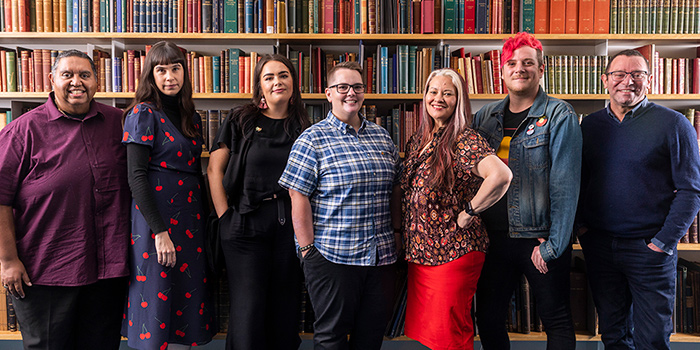
This resource is part of a national effort to provide culturally safe public spaces and services in libraries for Aboriginal and Torres Strait Islander peoples, and a supportive workplace for Aboriginal and Torres Strait Islander staff where they are able to confidently draw strength in their identity, culture and community. It is a long-term commitment from our national, state and territory libraries as members of NSLA, and recognises that each staff member will learn within their personal context.
The information held in our libraries is a powerful resource for Aboriginal and Torres Strait Islander peoples wishing to reconnect with family and community and to strengthen personal and cultural identities. The sensitivity and significance of these collection materials means we have a responsibility to ensure there are policies in place that deliver culturally respectful services to Aboriginal and Torres Strait Islander people.
About the Culturally Safe Libraries Program
In 2018, NSLA established the Aboriginal and Torres Strait Islander Culturally Safe Libraries Program to ensure that our libraries are culturally safe spaces and that staff working with Indigenous collections are well informed about content and access protocols, and about the history and cultural heritage of the Aboriginal and Torres Strait Islander peoples those collections relate to. NSLA libraries are committed to shared Indigenous cultural competency principles, including cultural competency training for all staff.
Because staff working directly with Aboriginal and Torres Strait Islander collections and content require a level of specialist knowledge, the Culturally Safe Libraries Program also includes role-specific training. This is based on protocols developed by the Aboriginal and Torres Strait Islander Library and Information Resource Network – known as the ATISILIRN Protocols.
How to use these materials
These resources are designed to give you a better understanding of the ATISLIRN Protocols and how they relate to your daily work with Aboriginal and Torres Strait Islander collection materials.
We suggest you explore the content under each of the protocols, which includes:
- introductory text and videos
- case studies from libraries demonstrating aspects of the protocols in action
- activities to help you reflect on what your library is doing well and identify areas for improvement
- further resources for each protocol, for those who want to explore them more deeply.
A note on copyright
All resources created for the Culturally Safe Library Program are licensed under Creative Commons (CC-BY). Under this licence, you are free to copy, distribute, remix and build upon this content as long as you acknowledge National and State Libraries Australia. The full legal code for the licence is available on the Creative Commons website.
Resources created by third parties, including NSLA member libraries and those linked to under ‘further resources’ for each protocol, retain the copyright status assigned by the creator.
What is a culturally safe library?
A library that provides an onsite and online environment that is emotionally safe for Aboriginal and Torres Strait Islander employees and clients; where people feel supported, can express themselves and their culture, history and identity with dignity and pride. An environment which fosters shared respect, meaning, knowledge and an opportunity to learn together without judgement.
The ATSILIRN Protocols
The original Aboriginal and Torres Strait Islander Protocols for Libraries, Archives and Information Services was published by ALIA in 1995. The protocols were endorsed by the Aboriginal and Torres Strait Islander Library, Information and Resource Network (ATSILIRN).
The protocols were updated a decade later and made available online, after it was recognised that there was little evidence of the extent of their use, or their value and effectiveness in library and information sector workplaces. In 2010, a twelfth protocol was added to reflect considerations resulting from digitisation, digital objects and the digital environment. In 2018 ATSILIRN became an ALIA group, with representatives from around Australia, including a number of NSLA libraries. A review of the protocols is slated for 2019-2020.
NSLA endorsed the ATSILRN protocols in a 2014 position statement intended to guide progressive action in our libraries’ plans and approaches to Aboriginal and Torres Strait Islander library services and collections. While all of our libraries have made progress in some areas covered by the protocols, the protocols themselves are still not embedded in the way we think about and work with our collections, or the peoples and communities to whom they belong. These resources, and the workshops presented in each NSLA library as part of the Culturally Safe Libraries Program, aim to address that gap.
Note: These resources only deal with the ATSILIRN Protocols that relate to Aboriginal and Torres Strait Islander collections. The protocols that relate to governance and management (Protocol 1), staffing (Protocol 8), developing professional practice (Protocol 9), and awareness of Aboriginal and Torres Strait Islander peoples and issues (Protocol 10) are being addressed in NSLA libraries in other facets of the Culturally Safe Libraries Program.